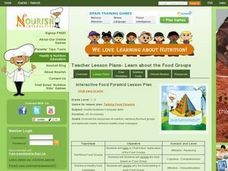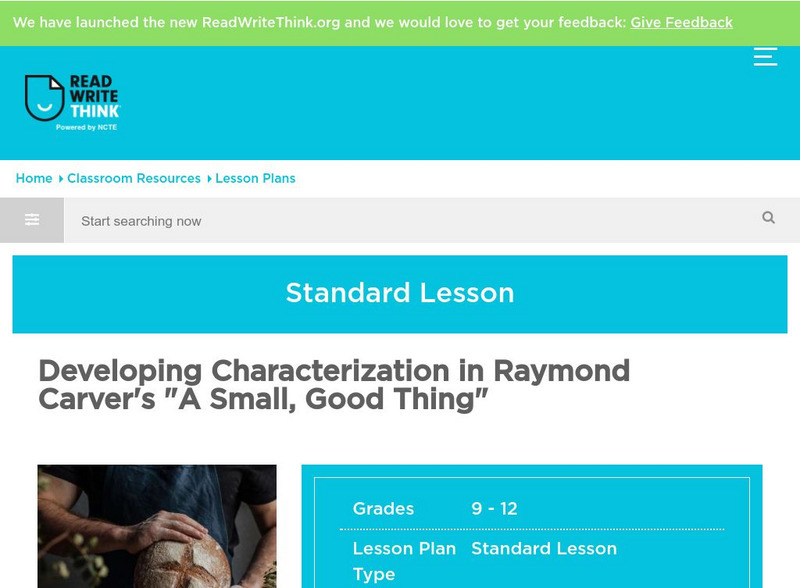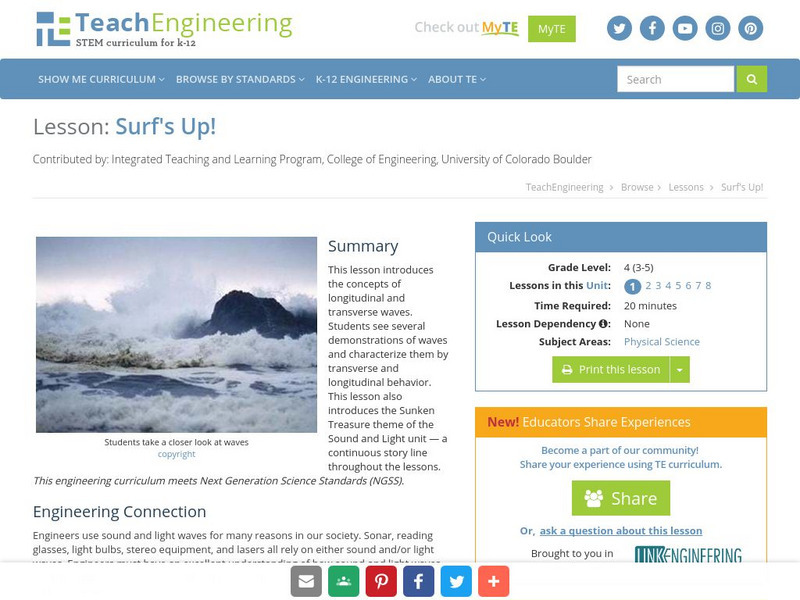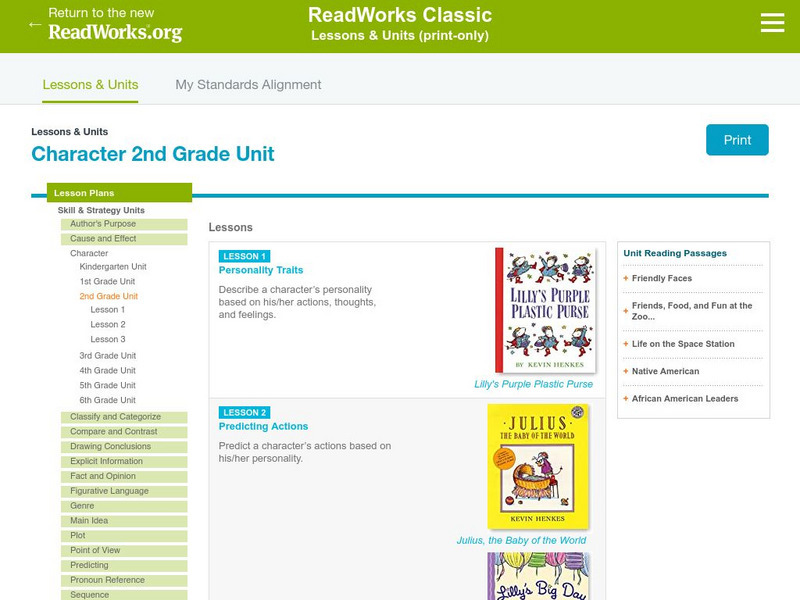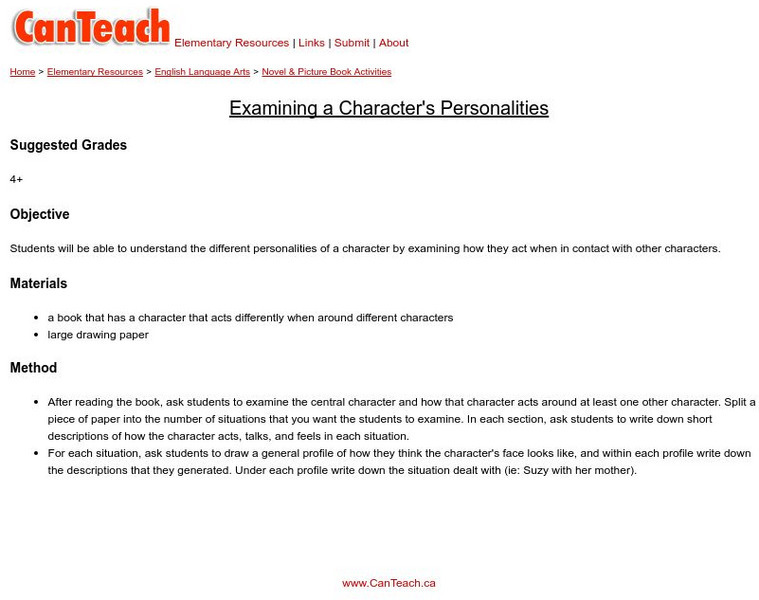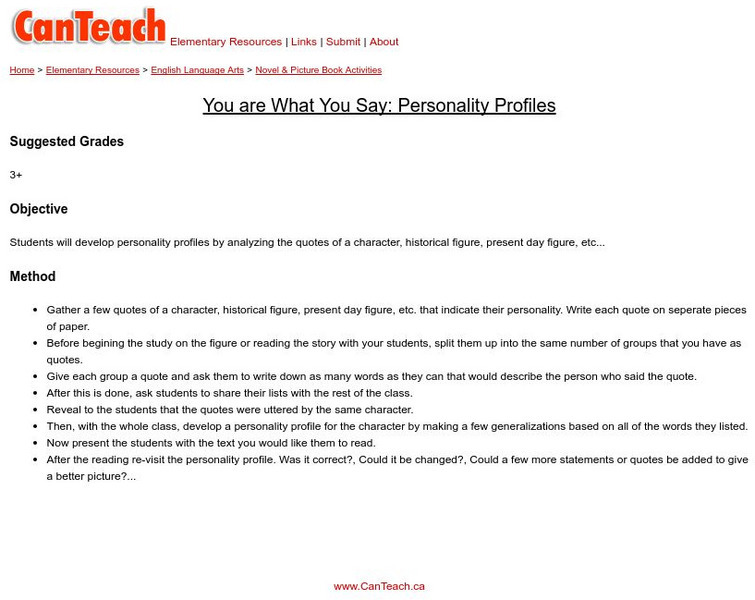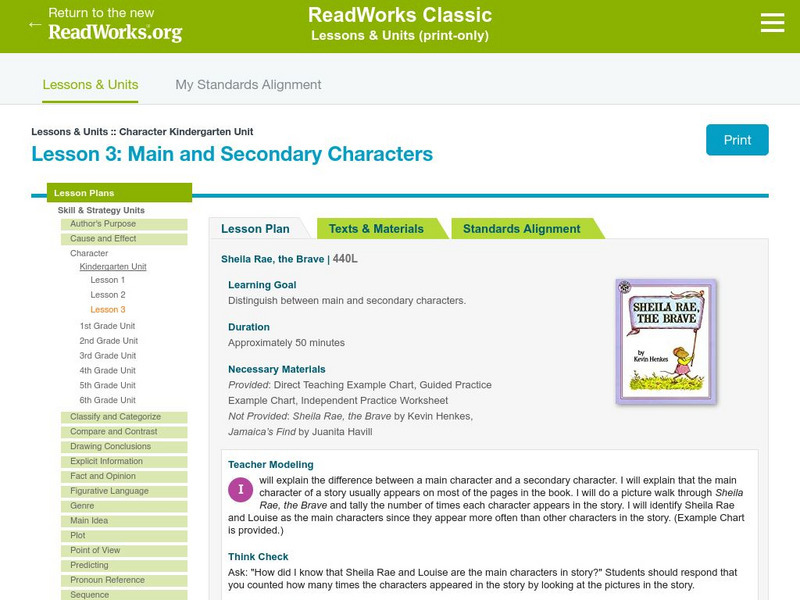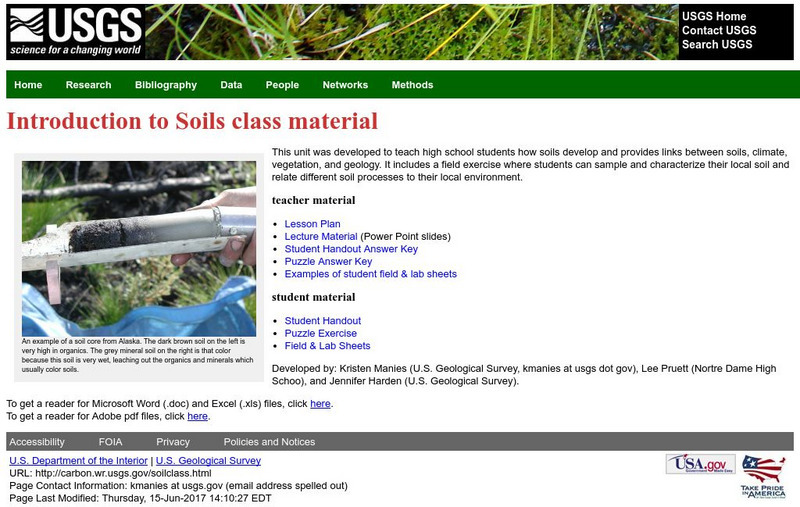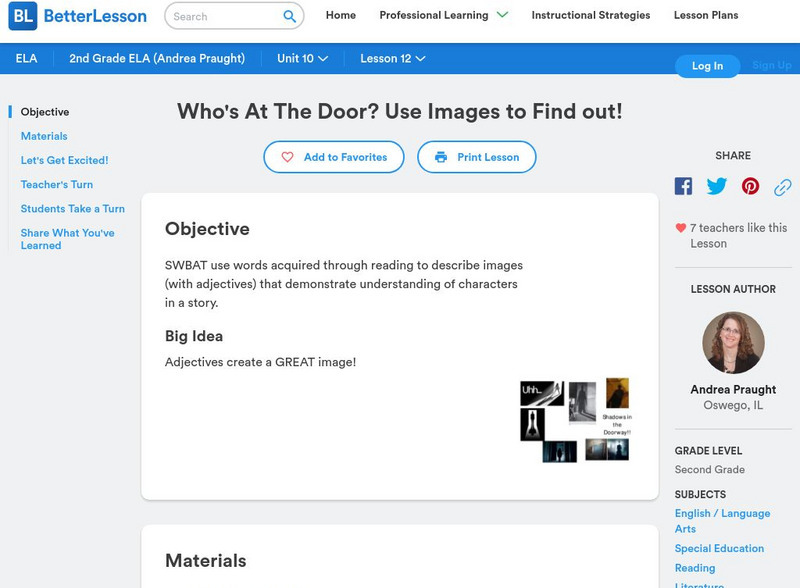Curated OER
The Death of the Ball Turret Gunner
Students read and analyze a poem about a speaker's posthumous view of war, assess the purpose of an author's note and evaluate the effect of the point of view on the reader's response. They work in groups to discuss and analyze the poem.
Curated OER
Interactive Food Pyramid
Students participate in the game, "Talking Food Pyramid." For this nutrition lesson, students recognize the organization of foods in to five groups. Students conclude by physically classifying a selection of foods in two groups.
ReadWriteThink
Read Write Think: Using Picture Books to Teach Characterization
Contains plans for two or three lessons that ask students to examine characterization in picture books to use as models for their own writing. In addition to objectives and standards, this instructional plan contains links to sites used...
ReadWriteThink
Read Write Think: Developing Characterization in Carver?s ?A Small, Good Thing
Contains plans for three lessons that teach characterization using Raymond Carver's short story "A Small, Good Thing." In addition to objectives and standards, this instructional plan contains links to PDF handouts and sites used in the...
British Library
British Library: Teaching Resources: Milton: Crime & Punishment in Paradise Lost
Through exploring characterization and setting in Paradise Lost, students will reflect on how transgressive actions and their consequences are presented, with particular reference to Books I, II, IX, and X. Included in this instructional...
TeachEngineering
Teach Engineering: Hidden in Plain Sight
Steganography is the science and art of hiding messages in plain sight so only the sender and intended recipient know the existence of a message. Steganography can be characterized as security through obscurity. Through this lesson,...
British Library
British Library: Teaching Resources: Othello: Critical Approaches
This activity allows students to consider how different critical approaches can influence a reading of the play. Students will work in groups to explore different attitudes to Othello by looking at a range of texts from the past,...
British Library
British Library: Teaching Resources: Measure for Measure: A Problem Play?
What is Measure for Measure's problem? The play confronts us with questions about sex, morality, and power, which challenge us as readers and audiences. In these activities, students will debate why the play is so problematic, through...
TeachEngineering
Teach Engineering: Surf's Up!
This lesson introduces the concepts of longitudinal and transverse waves. Students see several demonstrations of waves and characterize them by transverse and longitudinal behavior. This lesson also introduces the Sunken Treasure theme...
Read Works
Read Works: Grade 2: Three Lesson Unit: Character
[Free Registration/Login Required] A series of three lesson plans designed to teach students to recognize a character's personality traits, predict a character's actions, and describe a character using rich language. Lessons are based on...
British Library
British Library: Teaching Resources: Hamlet: Ophelia, Gender and Madness
In his portrayal of Hamlet and Ophelia, Shakespeare raises troubling questions about gender and madness. These activities encourage students to compare these two central characters, and how they have been used to reflect changing views...
Better Lesson
Better Lesson: Speaking and Listening: Collaborative Conversations
Students will partner read The Kite, by Alma Flor Ada. Then work together in small collaborative groups to describe the character of the mother, the children, or the kitten. Included in this lesson are video demonstrations, printable...
Can Teach
Can Teach: Examining a Character's Personalities
In this lesson plan students will be able to understand the different personalities of a character by examining how they act when in contact with other characters. Lesson plan indicated for 4th grade and above.
Can Teach
Can Teach: Introduction to Character Traits
In this lesson plan middle schoolers will better understand what and how to generate the traits of a character. Lesson plan indicated for 4th grade and above.
Can Teach
Can Teach: You Are What You Say Personality Profiles
In this lesson plan students will develop personality profiles by analyzing the quotes of a character, historical figure, present day figure, etc. Lesson plan indicated for 3rd grade and above.
ReadWriteThink
Read Write Think: Critical and Analytical Thinking About Literary Characters
Contains plans for four lessons that use the short story "After Twenty Years" by O. Henry to teach about characterization using word maps. In addition to objectives and standards, this instructional plan contains links to sites used in...
Read Works
Read Works: Kindergarten: Character: Lesson 3: Main and Secondary Characters
[Free Registration/Login Required] Based on stories Sheila Rae, the Brave and Jamaica's Find, this lesson plan will take students through the process of distinguishing main characters from secondary ones by relying on clues from the text...
National Endowment for the Humanities
Neh: Edsit Ement:narrative and Persona in the Poetry of Robert Frost
Using Frost's famous poem, "Stopping by the Woods on a Snowy Evening" as an example of narrative poetry, students explore the artistry and significance of the narrative poem. In addition, this lesson plan provides suggestions for writing...
US Geological Survey
U.s. Geological Survey: Introduction to Soils
This unit teaches students how soils develop and provides links between soils, climate, vegetation, and geology. It includes a field exercise where students can sample and characterize their local soil and relate different soil processes...
Better Lesson
Better Lesson: Who's at the Door? Use Images to Find Out!
Young scholars will use words acquired through reading to describe images (with adjectives) that demonstrate an understanding of characters in a story. The teacher will read Miss Nelson is Back which has great descriptors and will hold a...
British Library
British Library: Wilde's the Importance of Being Earnest: A Close Reading
In this lesson, students will consider several aspects of Oscar Wilde's most popular of comedies, "The Importance of Being Earnest". The success of this play is in part due to its examination of moral principles - in this case, the...
British Library
British Library: Bronte's Jane Eyre: The Figure of Bertha Mason
This activity will encourage students to explore the character of Bertha Mason, Mr. Rochester's first wife, through the lens of medical history. They will compare Charlotte Bronte's presentation of the character with the perspectives...
British Library
British Library: Bronte's Wuthering Heights: Who Is Heathcliff?
This activity involves an exploration of the notoriously multifaceted character of Heathcliff, drawing on a range of sources that include the visual, literary, and historical. Students will reflect on Emily Bronte's depiction of...
British Library
British Library: Bronte's Wuthering Heights: Fantasy and Realism
Students will consider the two elements of fantasy and realism that combine to create the compelling narrative in Wuthering Heights (1847). In this activity, students will explore the significance of nature within the narrative, its...



